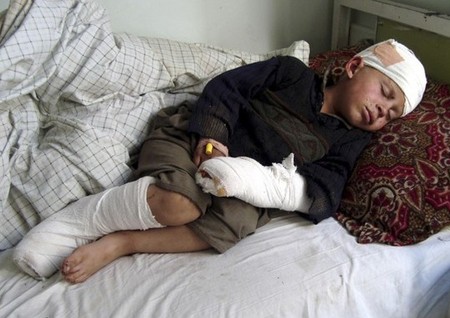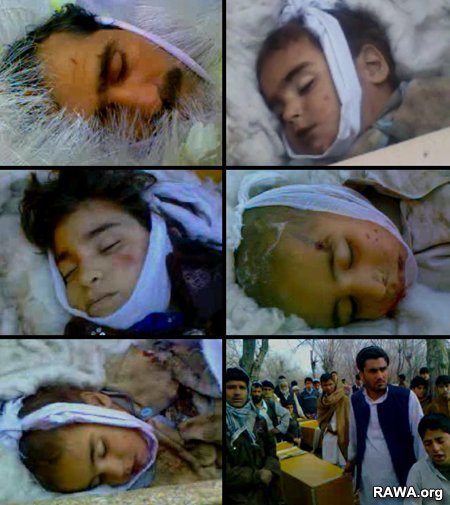Recent reports have raised concern about the impact of the war in Afghanistan on civilians in Afghanistan and in Pakistani border areas that have been the focus of drone strikes targeting Taliban leaders.
In Afghanistan, the first two months of 2011 saw a dramatic deterioration in the security situation for ordinary Afghans, the International Committee for the Red Cross said March 15.

A boy, injured during a NATO air strike, lies on a hospital bed in Afghanistan's eastern Kunar province February 20, 2011. Joint operations by Afghan forces and NATO-led foreign troops killed 64 civilians in Kunar, including many women and children, over the past four days, the governor of Kunar said on Sunday. (Photo: Reuters)
Suicide bombings in public places where civilians congregate, roads mined with improvised explosive devices and civilian casualties resulting from international combat operations all have added to Afghans’ suffering.
“People tell us that they are caught in the middle of the conflict and they don’t know which way to turn,” said the ICRC’s head of delegation, Reto Stocker. “It is an untenable situation. Civilians must be protected from harm as much as possible, not become victims of the fighting.”
The dangerous conditions have compromised health care services in remote areas as clinics close, doctors and nurses flee and roads are blocked by checkpoints or fighting, the ICRC said.
“The conflict continued to have a devastating impact on women and children,” with 1,175 women and 555 children killed in 2010, the United Nations Assistance Mission in Afghanistan said in a report in March. “More women and children were killed and injured than in 2009. Women casualties increased by six percent and child casualties increased by 21 percent from 2009.”
Over the past four years, 8,832 civilians have been killed in the conflict, with civilian deaths increasing each year, UNAMA said.
Insurgents were responsible for 75 percent of the 2,777 deaths in 2010, up 28 percent from the year before.
Pro-government forces were responsible for 16 percent of the deaths, compared with 26 percent the prior year.
Coalition forces have reduced their civilian casualties overall but a recent increase in helicopter combat operations has created a new source of danger for civilians, the Wall Street Journal reported.
Nine Afghan boys collecting firewood were killed March 1 in Kunar province in eastern Afghanistan when they were mistakenly targeted by coalition helicopters hunting for insurgents. On March 14 two boys watering their field were killed in the same district when a helicopter fired on them, and a commander and a helicopter crew were suspended pending an investigation, Long War Journal reported.

A soldier, his wife and four children were killed in a NATO overnight raid in the Qilgha village in eastern Afghanistan on February 21, 2011. (Photos: RAWA.org)
The 233 reported drone strikes in northwest Pakistan, including 20 in 2011, from 2004 to the present have killed approximately between 1,411 and 2,247 individuals, of whom around 1,134 to 1,810 were described as militants in reliable press accounts, New America Foundation said in a report March 16.
A March 17 drone attack in the tribal region of North Waziristan killed 40 people, the Pakistani government said. Pakistan Foreign Secretary Salman Bashir demanded an apology and explanation, and the Pakistani government called the attack “not only unacceptable but also a flagrant violation of all humanitarian rules and norms.”
The U.S. government said the attack targeted insurgents. “These people weren’t gathering for a bake sale,” The New York Times quoted an American official as saying. “They were terrorists.”
– Compiled by Catholic San Francisco
Published originally on Mar. 30, 2011



